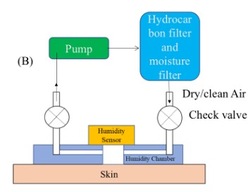A total evaporative water loss measurement device
TECHNOLOGY NUMBER: 2023-240

OVERVIEW
A closed chamber transepidermal water loss measurement device using dry and clean air- An active pump purges, cleans, and dries the skin surface as well as the detection chamber
- Exceeds existing systems by continuous monitoring, low energy consumption, and no ambient interference
BACKGROUND
Transepidermal water loss (TEWL) is defined as the flux of water diffusing through the stratum corneum of the skin. Diseases in which the skin barrier is disturbed, such as atopic dermatitis, contact dermatitis, and psoriasis, are associated with elevated TEWL. Given that TEWL is a key indicator of the skin barrier function, its measurement proves essential in a wide range of clinical and personal care applications. Existing TEWL measurement devices fall either into those with an open system or devices with a closed system. In the open system, two humidity sensors measure the water vaper concentration gradient to obtain the water flux, or TEWL. While the advantages of the open system include ease of construction, continuous monitoring, and low power use, it is susceptible to environmental variations in air flow, ambient humidity, and temperature. Closed systems are less susceptible to environmental changes, though they are not capable of continuous monitoring and do not take into account the presence of skin surface water. So, a need exists for an improved device to accurately and easily measure TEWL.
INNOVATION
Researchers have invented a technology that provides transepidermal water loss (TEWL) measurements in a manner that corrects for limitations in existing devices through the use of a closed chamber and dry clean air supply. Through this method, an active pump provides dry and clean air from either an external or internal source to first purge, clean, and dry the skin surface as well as the detection chamber away from the skin. The skin and humidity sensor in the detection chamber therefore become dry with a relative humidity (RH) close to 0%, and the TEWL can be extracted from subsequent humidity readings as the skin releases moisture. The invention allows for a marked improvement over existing systems that require significant energy to decrease humidity by cooling a closed chamber and collecting water vapor on condensing coils. This advancement provides improved patient comfort with wearable technology, continuous monitoring, low energy consumption, and no ambient interference.